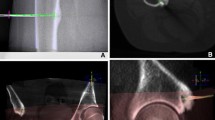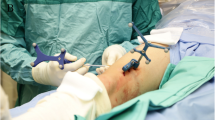Abstract
Objective
We describe a novel and safe needle-holding method that we have termed the ‘dual steristrip technique’. This technique can be used to stabilize the bone biopsy needle without the need for the radiologist’s hand to be in close proximity to the X-ray beam during CT-guided intervention.
Materials and methods
The dual steristrip technique uses steristrips to stabilize the bone biopsy needle and allows for accurate assessment of needle position and trajectory. This involves affixing one end of a steristrip to the skin 2 cm from the needle skin entry point, wrapping the mid-section of the steristrip around the biopsy needle and affixing the other end of the steristrip to the skin at the opposite side of the needle 2 cm from the needle skin entry point. A second steristrip is then applied in a similar fashion at 90° to the first steristrip.
Results
In our institution, we have used the dual steristrip technique to stabilize the biopsy needle in certain cases where assessment of needle position/trajectory can be more challenging. This includes cases where there is a paucity of soft tissues overlying the bone or if the bone lesion is located in the superficial cortex. We have found it to be successful in 80% of cases.
Conclusions
The dual steristrip technique is a safe and effective needle stabilization method that should be considered by the interventional radiologist in challenging CT-guided bone biopsy cases.



Similar content being viewed by others
References
Teeuwisse WM, Geleijns J, Broerse JJ, Obermann WR, Van Persijn van Meerten EL. Patient and staff dose during CT-guided biopsy, drainage and coagulation. Br J Radiol. 2001;74:720–6.
Olerud HM, Obberg S, Widmark A, Hauser M. Physician and patient radiation dose in various CT-guided biopsy protocols. In: Sixth European ALARA network on “occupational exposure optimisation in the medical field and radiopharmaceutical industry”. Madrid, Spain, 23–25 October 2002.
Jungnickel K. Radiation protection during CT-guided interventions. In: Mahnken AH, Ricke J, editors. CT- and MR-guided interventions in radiology. New York: Springer; 2009. p. 35–8.
Nawfel RD, Philip FJ, Silverman SG, et al. Patient and personnel exposure during CT fluoroscopy-guided interventional procedures. Radiology. 2000;216:180–4.
Stoeckelhuber BM, Leibecke T, Schulz E, et al. Radiation dose to the radiologist’s hand during continuous CT fluoroscopy-guided interventions. Cardiovasc Intervent Radiol. 2005;28:589–94.
Neeman Z, Dromi SA, Sarin S, Wood BJ. CT fluoroscopy shielding: decreases in scattered radiation for the patient and operator. J Vasc Interv Radiol. 2006;17(12):1999–2004.
Schueler BA. Operator shielding: how and why. Tech Vasc Interv Radiol. 2010;13:167–71. https://doi.org/10.1053/j.tvir.2010.03.005.
Irie T, Kajitani M, Matsueda K, Arai Y. Biopsy of lung nodules with use of II device under intermittent CT fluoroscopic guidance: preliminary clinical study. J Vasc Interv Radiol. 2001;12:215–9.
Silverman SG, Tuncali K, Adams DF, Nawfel RD, Zou KH, Judy PF. CT fluoroscopy-guided abdominal interventions: techniques, results, and radiation exposure. Radiology. 1999;212:673–81.
Kim GR, Hur J, Lee SM, et al. CT fluoroscopy-guided lung biopsy versus conventional CT-guided lung biopsy: a prospective controlled study to assess radiation doses and diagnostic performance. Eur Radiol. 2011;21:232–9.
Roberts CC, Morrison WB, Deely DM, Zoga AC, Koulouris G, Winalski CS. Use of a novel percutaneous biopsy localization device: initial musculoskeletal experience. Skelet Radiol. 2007;36:53–7.
Magnusson A, Radecka E, Lönnemark M, Raland H. Computed-tomography-guided punctures using a new guidance device. Acta Radiol. 2005;46(5):505–9.
Kroes MW, et al. Assessment of needle guidance devices for their potential to reduce fluoroscopy time and operator hand dose during C-arm cone-beam computed tomography-guided needle interventions. J Vasc Interv Radiol. 2013;24(6):901–6.
Author information
Authors and Affiliations
Corresponding author
Ethics declarations
Conflict of interest
There are no conflicts of interest.
Additional information
Publisher’s note
Springer Nature remains neutral with regard to jurisdictional claims in published maps and institutional affiliations.
Rights and permissions
About this article
Cite this article
McLoughlin, E., Iqbal, A., Patel, A. et al. Dual steristrip technique: a novel use of steristrips to reduce operator radiation dose during CT-guided intervention. Skeletal Radiol 48, 1617–1620 (2019). https://doi.org/10.1007/s00256-019-03211-2
Received:
Revised:
Accepted:
Published:
Issue Date:
DOI: https://doi.org/10.1007/s00256-019-03211-2




